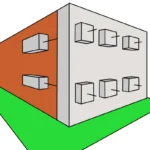Concrete Mix Design
Concrete mix design, also known as concrete mix, stands as a fundamental pillar in civil engineering, a facet often overlooked when contemplating our infrastructures, buildings, and roads. The quality and durability of the concrete used in their construction have a decisive impact on the integrity and longevity of these structures. This discipline, encompassing everything from formulating recipes to selecting materials, is considered a crucial component in the construction of durable and safe buildings and structures.
Importance of Concrete Mix Design
In Civil Engineering
Concrete mix design is essential in civil engineering for the following reasons:
Structural Safety: The quality of concrete mixes is crucial to ensure the safety of structures. Inadequate design can lead to structural weaknesses and potential collapses.
Durability: Well-designed concrete structures are long-lasting and resistant to adverse weather and environmental factors, reducing the need for costly repairs and replacements over time.
Cost Efficiency: Proper mix design allows for efficient use of materials, resulting in cost savings on construction projects.
Sustainability: Optimizing concrete mixes can reduce the consumption of natural resources, benefiting the environment and contributing to the sustainability of construction.

In Society
In addition to its relevance in civil engineering, methods for concrete mix design also impact society in various ways:
Safe Infrastructure: The use of well-designed concrete ensures that our roads, bridges, and buildings are safe for use, essential for people’s mobility and daily life.
Housing Quality: In residential contexts, concrete mix design influences the quality and durability of homes, providing families with a safe and comfortable environment.
Economic Development: Robust infrastructure supported by quality concrete contributes to economic growth by facilitating trade, investment, and industrial expansion.
Waste Reduction: Efficient concrete mix design can reduce construction waste, promoting more sustainable practices in the construction industry.
Requirements for Concrete Mix Design
To ensure the quality, durability, and safety of concrete structures, several key requirements must be met. Here is an analysis of the fundamental requirements for concrete mix design:
Compressive Strength: This is one of the most critical requirements. Compressive strength refers to concrete’s ability to withstand compression loads. Building codes and project specifications establish the minimum strength values required for a specific structure.
Workability: Concrete mix must be manageable enough to be easily placed and compacted. This is achieved by controlling the amount of water and choosing the right aggregates and additives. Workability is essential to ensure uniform distribution of concrete and prevent segregation and air bubble formation.
Durability: Concrete must be durable and capable of withstanding exposure to adverse environmental factors such as moisture, temperature, and chemicals. This involves selecting appropriate materials and adding additives to enhance corrosion resistance and durability.
Water-Cement Ratio: The water-cement ratio is crucial in determining concrete’s strength and workability. Excessive water can weaken the mix and reduce its strength, while a low water-cement ratio can make the mix too dry and difficult to work with
Size and Type of Aggregates: The choice of aggregates, such as sand and gravel, is important. Aggregates must meet certain size, shape, and cleanliness requirements. Additionally, the particle size distribution of aggregates influences workability and concrete strength.
Additives and Admixtures: Additives and admixtures, such as plasticizers, retarders, or fibers, are used to improve certain properties of concrete. For example, plasticizers can enhance workability, while retarders can delay setting. The selection and quantity of these materials depend on project requirements.
Quality Control and Testing: Laboratory and field tests must be conducted to ensure that the mix meets specified requirements. This includes tests for compressive strength, workability, density, and other relevant parameters.
Regulatory Compliance: Concrete mix design must comply with applicable local and international codes and regulations. These codes establish minimum standards of quality and safety to be followed in construction.
Environmental Considerations: In many cases, environmental considerations such as reducing carbon emissions must be taken into account. This can influence the choice of materials and more sustainable mixing methods.
Procedure of Design Methods
Below, we will describe the procedures of the mentioned methods:
ACI Method (American Concrete Institute)
The ACI method, endorsed by the American Concrete Institute (ACI), is one of the most widely used in the industry and is based on four key steps:
Determination of Requirements: Strength, workability, and durability goals are established based on applicable regulations and specifications.
Material Selection: Materials such as cement type, aggregates, and additives are carefully chosen, and data on their properties is collected.
Calculations and Adjustments: Equations and graphs provided by ACI are used to calculate the proper proportions of materials to achieve the desired mix.
Testing and Final Adjustments: A test mix is prepared and adjusted if necessary through laboratory testing before large-scale production.
Weymouth and Fuller-Thompson Method
This method focuses on the water-cement ratio and is particularly useful for designing high-performance mixes. The procedure comprises three fundamental steps:
Water-Cement Ratio Determination: The desired ratio is chosen based on project requirements.
Weymouth Curve Selection: A specific graph known as the “Weymouth Curve” is used to select the appropriate proportions of sand, gravel, and cement to achieve the desired water-cement ratio.
Final Adjustments: Laboratory tests are conducted, and the mix is adjusted as necessary to meet the required properties.
Bolome Method
Based on the relationship between cement content and relative aggregate density, this method follows these steps:
Requirements Definition: Strength and workability goals for the concrete are established.
Bolomey Graph: A graph relating cement content and relative aggregate density is used to determine the proper proportions.
Final Adjustments and Testing: The mix is adjusted as necessary, and tests are performed to verify compliance with specifications.
Faury Method
Similar to the Bolomey method, this approach focuses on the relationship between cement content and relative aggregate density:
Requirements Definition: Strength and workability goals for the concrete are established.
Faury Graph: A graph is used to calculate the appropriate proportions.
Final Adjustments and Testing: The mix is adjusted, and tests are conducted to ensure compliance with specifications.

Similarities and Differences
In the field of civil engineering, choosing the right method for concrete mix design is crucial. Each method has its own characteristics and approaches, leading to significant similarities and differences in mix formulation.
Similarities among the Methods
Focus on Specific Requirements: All methods share the premise of meeting the required strength and workability for a specific construction project. They are based on regulations and specifications to establish specific objectives.
Use of Material Data: In all four methods, detailed information about the materials used, such as cement type, aggregates, and additives, is required. The quality of these materials greatly influences the final mix.
Final Adjustments and Testing: Each method allows for adjusting the concrete mix through laboratory testing. This ensures that the required standards are met before large-scale production.
Differences among the Methods
ACI Method (American Concrete Institute):
Wide Applicability: The ACI method is versatile and applicable to a wide range of projects and strength requirements.
Detailed Calculations: It uses equations and graphs to determine the appropriate proportions of materials, allowing for greater precision.
Weymouth and Fuller-Thompson Method:
Focus on Water-Cement Ratio: This method centers on the water-cement ratio and uses the “Weymouth Curve” to select material proportions.
Specialized for High-Performance Mixes: It is primarily used for projects requiring high-performance and durable mixes.
Bolome Method and Faury Method:
Relationship between Cement Content and Relative Aggregate Density: They are based on the relationship between cement content and relative aggregate density, using specific graphs to determine appropriate proportions.
Application in Cost-Effective Design: They are especially useful for projects where material cost optimization is a priority.
Conclusion
In summary, concrete mix design methods represent an irreplaceable pillar in the construction of quality and durable structures. The choice of the appropriate method is closely linked to the specifics of each project and prevailing local regulations. Through a deep understanding of these methods and their procedures, engineering and construction students have the opportunity to play an essential role in the field of construction.
Ultimately, these methods are essential in civil engineering, as they directly influence people’s quality of life and sustainable societal development. Their relevance lies in their ability to ensure the safety, durability, and cost efficiency of structures, which in turn drives economic growth and environmental preservation. The precise understanding and application of these methods are imperative to ensure the integrity of constructions and the overall well-being of society. In the end, they are a testament to the diversity and adaptability in the field of concrete mix design, where the right method choice becomes a critical factor in the success of any construction project. So go ahead, young engineers and builders, your knowledge and determination can build a stronger and more sustainable future!







Related
Differences Between Concrete and Mortar in Civil Engineering and Construction.